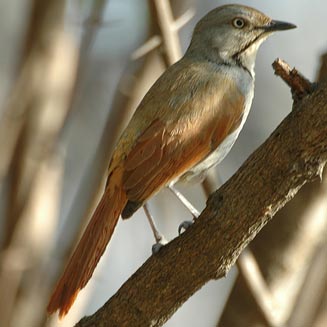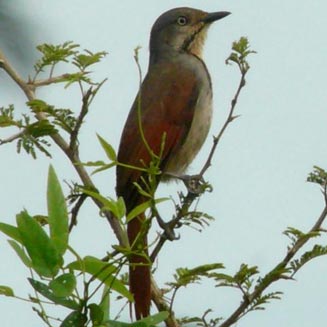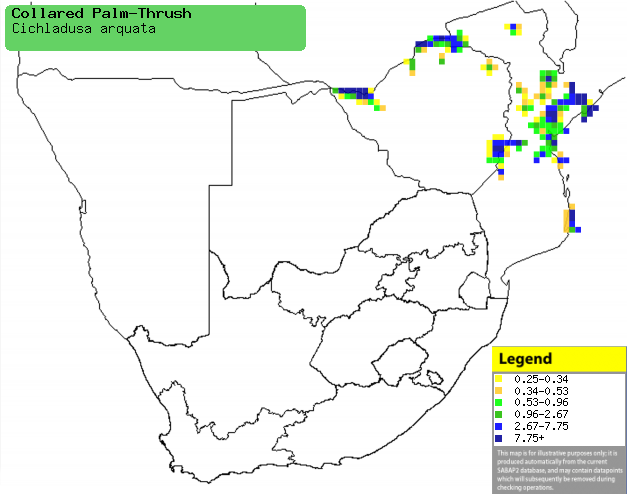|
Cichladusa arquata (Collared palm-thrush)
Palmmôrelyster [Afrikaans]; Zambesi-palmlijster [Dutch]; Cichladuse à
collier [French]; Morgenrötel [German]; Tordo-das-palmeiras-de-colar
[Portuguese]
Life
> Eukaryotes >
Opisthokonta
> Metazoa (animals) >
Bilateria >
Deuterostomia > Chordata >
Craniata > Vertebrata (vertebrates) > Gnathostomata (jawed
vertebrates) > Teleostomi (teleost fish) > Osteichthyes (bony fish) > Class:
Sarcopterygii (lobe-finned
fish) > Stegocephalia (terrestrial
vertebrates) > Tetrapoda
(four-legged vertebrates) > Reptiliomorpha > Amniota >
Reptilia (reptiles) >
Romeriida > Diapsida > Archosauromorpha > Archosauria >
Dinosauria
(dinosaurs) > Saurischia > Theropoda (bipedal predatory dinosaurs) >
Coelurosauria > Maniraptora > Aves
(birds) > Order: Passeriformes
> Family: Muscicapidae > Genus: Cichladusa
 |
 |
|
Collared palm-thrush, Liwonde National Park,
Malawi. [photo
Willem Frost ©] |
Collared palm-thrush, Tanzania. [photo
Justin Stahl
©] |
Distribution and habitat
Occurs from southern Kenya, Tanzania and southern DRC
through Malawi and Zambia to southern Africa. Here it occurs in central
Mozambique and in patches along the border of Zimbabwe, generally preferring
thickets with palm trees (such as Phoenix, Borassus and
Hyphaene) near water. It may also occupy gardens and mixed bushwillow (Combretum)
and Mopane (Colosphermum mopane) woodland around human settlements.
|
 |
|
Distribution of Collared palm-thrush in southern Africa,
based on statistical smoothing of the records from first SA Bird Atlas
Project (©
Animal Demography unit, University of
Cape Town; smoothing by Birgit Erni and Francesca Little). Colours range
from dark blue (most common) through to yellow (least common).
See here for the latest distribution
from the SABAP2. |
Food
It mainly eats insects supplemented with amphibians, doing
most of its foraging in leaf litter, occasionally gleaning food from foliage. The following food items have been recorded
in its diet:
- Invertebrates
-
Hemiptera (bugs)
- Nezara viridula (Green vegetable bug)
- Lygaeidae (seed bugs)
- Corixidae (water boatmen)
- Notonectidae (backswimmers)
- moths and caterpillars (Lepidoptera)
- Coleoptera
(beetles)
- grasshoppers and crickets (Orthoptera)
- cockroaches (Blattidae)
- Forficula (brown earwig)
-
termites
- ants
-
centipedes
- Amphibians
Breeding
- The nest is either a semi-circular or
truncated cone-shaped structure, built of mud and grass roots and lined with
finer grass or fibres stripped from palm leaves. Both sexes construct it,
carrying material along the same route, repeatedly calling from perches
along the way. It is typically attached to
a hanging palm leaf, or at the point where the palm frond connects to the
trunk; it may also be placed in the leafy foliage of a dragon-tree (Dracaena),
under the eaves of a building or even in a working air-conditioning unit.
- Egg-laying season is from October-March.
- It lays 2-3 eggs, which are incubated by both adults for about 13 days.
- The chicks are fed by both parents on a diet of invertebrates. such as
caterpillars and grasshoppers, leaving the nest at 20 days old (in one observation).
Threats
Not threatened.
References
-
Hockey PAR, Dean WRJ and Ryan PG 2005. Roberts
- Birds of southern Africa, VIIth ed. The Trustees of the John Voelcker
Bird Book Fund, Cape Town.
|
